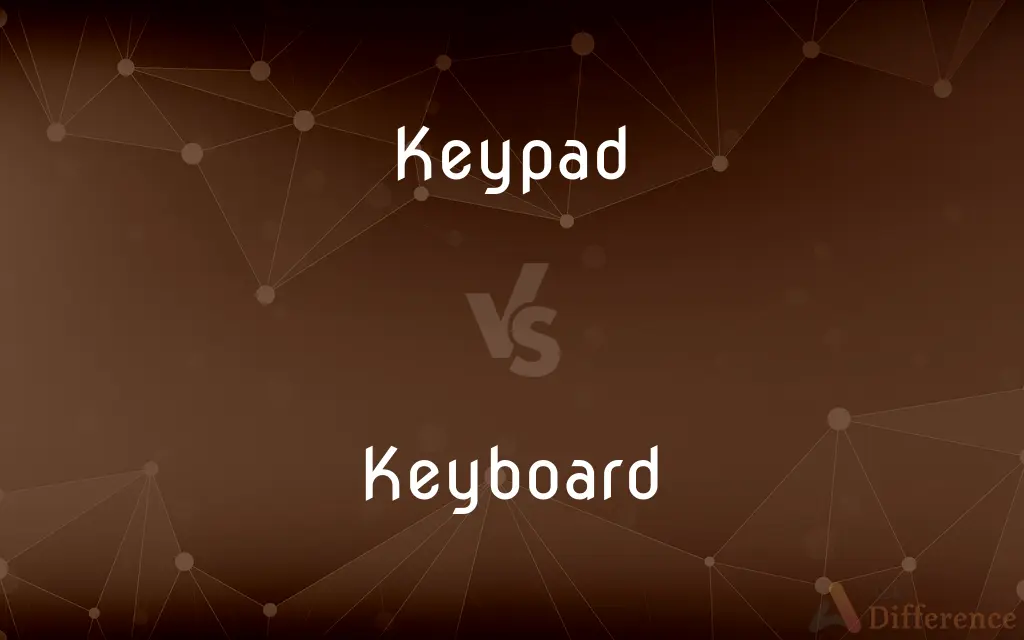Keypad vs. Keyboard — What's the Difference?
Edited by Tayyaba Rehman — By Fiza Rafique — Updated on November 1, 2023
A keypad is a small set of keys for numeric input or specific functions, while a keyboard is a larger set of keys including letters, numbers, and functions.

Difference Between Keypad and Keyboard
Table of Contents
ADVERTISEMENT
Key Differences
A keypad generally refers to a smaller, more limited array of keys, often numeric, used for specific functions like entering a PIN or navigating a menu. Keyboards, on the other hand, feature a full set of keys, including alphabetic, numeric, and punctuation keys, for comprehensive data input. Keypads are usually found on devices like phones, security systems, and ATMs, whereas keyboards are associated with computers.
Keyboards are designed for extensive typing and data entry, with keys that include letters of the alphabet, numbers, symbols, and other function keys. Keypads are more specialized, often focusing on a specific set of inputs, and they may not include the full range of characters and functions that a keyboard does. For instance, a keyboard allows for word processing, while a keypad might be used to dial a phone number.
When it comes to size, keyboards are larger and are meant to accommodate both hands for typing. Keypads are compact and can be easily operated with one hand or even just a thumb. This makes keyboards ideal for desktop computing, while keypads are perfect for handheld devices or control panels where space is limited.
Keyboards can often be programmable, with the ability to set shortcuts and macros, catering to an efficient typing experience. Keypads may have some programmable features but are usually fixed in their function, designed for quick and repetitive tasks. Both are essential in modern technology, but keyboards offer more versatility for different tasks.
In terms of connectivity, keyboards often connect to computers via USB or Bluetooth and are integral to the user interface. Keypads may be built into devices or serve as standalone units connected to a system for specific functions like access control. The way in which they connect can also differ, with some keypads requiring hard-wiring, while keyboards are typically plug-and-play.
ADVERTISEMENT
Comparison Chart
Size
Small, compact
Larger, full-sized
Key Variety
Limited, often numeric
Extensive, includes letters and symbols
Purpose
Specific functions like dialing
General typing and computer interaction
Usage
One-handed operation
Two-handed typing
Connectivity
Often built-in or hardwired
Commonly uses USB or Bluetooth
Compare with Definitions
Keypad
A set of buttons on a phone for dialing numbers.
He dialed his friend's number using the keypad.
Keyboard
A set of keys for typing on a computer.
She typed her essay on the keyboard.
Keypad
A component of a remote or device for command input.
He pressed the pause button on the TV remote's keypad.
Keyboard
An input accessory with keys for special functions.
Gamers often use a keyboard with macro keys.
Keypad
A cluster of keys for controlling a machine.
The technician adjusted the settings using the keypad.
Keyboard
A device for electronic data entry.
The programmer used the keyboard for coding.
Keypad
Numeric buttons for entering a PIN at an ATM.
She cautiously keyed in her PIN on the ATM's keypad.
Keyboard
A panel of keys for operating a typewriter.
The novelist preferred the feel of a typewriter's keyboard.
Keypad
A small panel with buttons for operation.
She entered her code on the security keypad.
Keyboard
A musical instrument with keys.
He played a melody on the keyboard.
Keypad
A keypad is a block or pad of buttons set with an arrangement of digits, symbols, or alphabetical letters. Pads mostly containing numbers and used with computers are numeric keypads.
Keyboard
A panel of buttons used for typing and performing other functions on a computer or typewriter.
Keypad
An input device consisting of a set of keys that are typically numeric and arranged in a grid, as on a cellphone or calculator.
Keyboard
A row of levers that are depressed with the fingers to produce or modulate the sound of an instrument, such as a piano or organ.
Keypad
A small board with keys primarily used for tactile input into a machine.
Many laptop computers have special function keys which turn part of the alphabetical keyboard into a numeric keypad.
Keyboard
Any of various instruments, played by means of a musical keyboard, often connected to a synthesizer or amplifier.
Keypad
A keyboard that is a data input device for computers; arrangement of keys is modelled after the typewriter keyboard
Keyboard
To set (copy) by means of a keyed typesetting machine
Keyboard a manuscript.
Keyboard
To enter (text or data) into a computer by means of a keyboard.
Keyboard
(Music) To play (a composition) on a piano or keyboard.
Keyboard
A set of keys used to operate a typewriter, computer etc.
Keyboard
(music) A component of many instruments including the piano, organ, and harpsichord consisting of usually black and white keys that cause different tones to be produced when struck.
Keyboard
(music) A device with keys of a musical keyboard, used to control electronic sound-producing devices which may be built into or separate from the keyboard device.
Keyboard
(intransitive) To type on a computer keyboard.
Keyboarding is the part of this job I hate the most.
Keyboard
The whole arrangement, or one range, of the keys{3} of an organ, piano, typewriter, etc.; that part of a device containing the keys{3} used to operate it.
Keyboard
Device consisting of a set of keys on a piano or organ or typewriter or typesetting machine or computer or the like
Keyboard
Holder consisting of an arrangement of hooks on which keys or locks can be hung
Common Curiosities
Is a keyboard always part of a computer?
While commonly used with computers, keyboards can also be standalone musical instruments or part of other devices.
Are all keyboards QWERTY?
No, there are various keyboard layouts like AZERTY or Dvorak, but QWERTY is the most common.
Can keypads be used for gaming?
Yes, but they are less common and typically specialized for certain functions, unlike full gaming keyboards.
Are keyboards wireless?
Keyboards can be wired or wireless, depending on the design and intended use.
Can a keypad have letter keys?
Some keypads have letters, but they are usually limited and combined with numbers, like on a telephone.
Do keyboards need software to work?
Basic keyboard functions don't need software, but advanced features might require specific drivers or software.
Is a touchpad the same as a keypad?
No, a touchpad is a touch-sensitive input device, while a keypad has physical buttons.
Do all keyboards have numeric keys?
Most full-size keyboards have a numeric section, but some compact designs may not include it.
Are keypads ergonomic?
Keyboards are more likely to be designed for ergonomics, whereas keypads are generally simple and compact.
Do keypads come with a computer?
No, keypads are usually separate and may be used for other devices like security systems.
Can you type a letter on a numeric keypad?
Some numeric keypads allow letter input by pressing a key multiple times, similar to old mobile phones.
Are membrane keypads different from mechanical keyboards?
Yes, membrane keypads operate by electrical contact between the surface layers, while mechanical keyboards have individual switches under each key.
Can keyboards be customized?
Yes, many keyboards allow customization of keycaps, backlighting, and key functions.
Can you connect a keyboard to a tablet?
Yes, many tablets can be used with keyboards via Bluetooth or a physical connection.
Can a keypad have programmable keys?
Yes, some keypads have programmable keys for specific functions or shortcuts.
Share Your Discovery

Previous Comparison
Scrapper vs. Scraper
Next Comparison
Cottage vs. BungalowAuthor Spotlight
Written by
Fiza RafiqueFiza Rafique is a skilled content writer at AskDifference.com, where she meticulously refines and enhances written pieces. Drawing from her vast editorial expertise, Fiza ensures clarity, accuracy, and precision in every article. Passionate about language, she continually seeks to elevate the quality of content for readers worldwide.
Edited by
Tayyaba RehmanTayyaba Rehman is a distinguished writer, currently serving as a primary contributor to askdifference.com. As a researcher in semantics and etymology, Tayyaba's passion for the complexity of languages and their distinctions has found a perfect home on the platform. Tayyaba delves into the intricacies of language, distinguishing between commonly confused words and phrases, thereby providing clarity for readers worldwide.














































